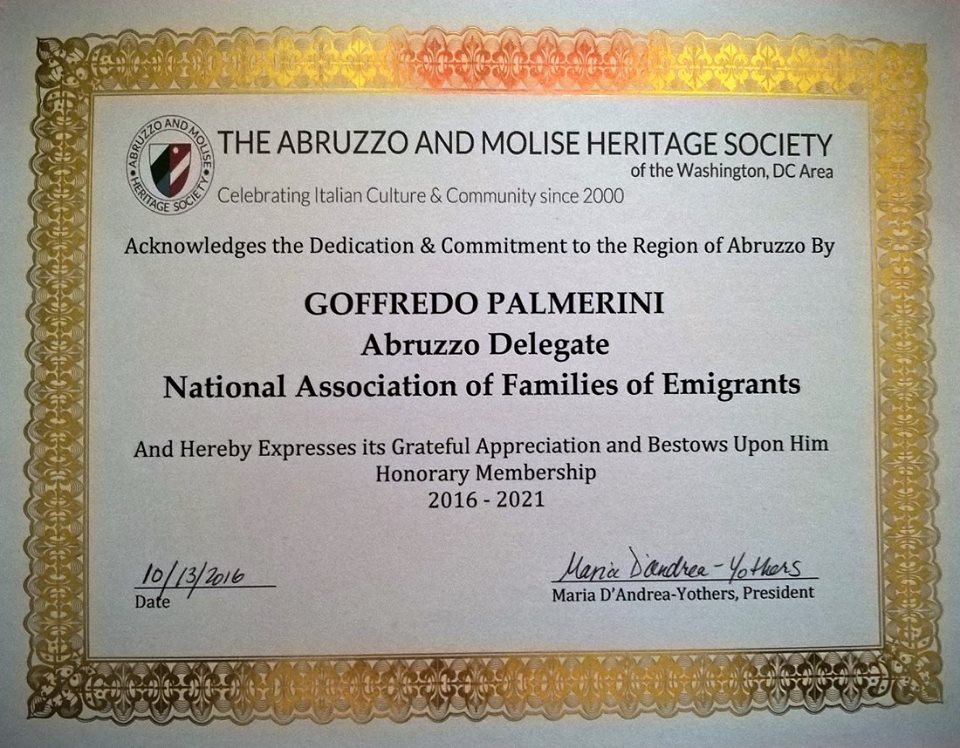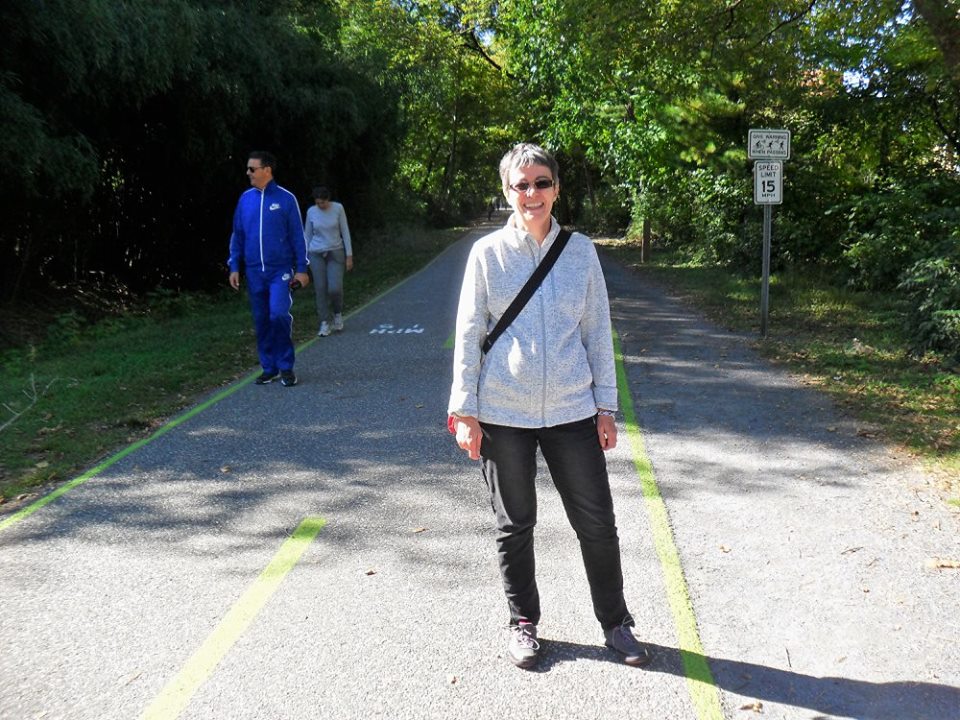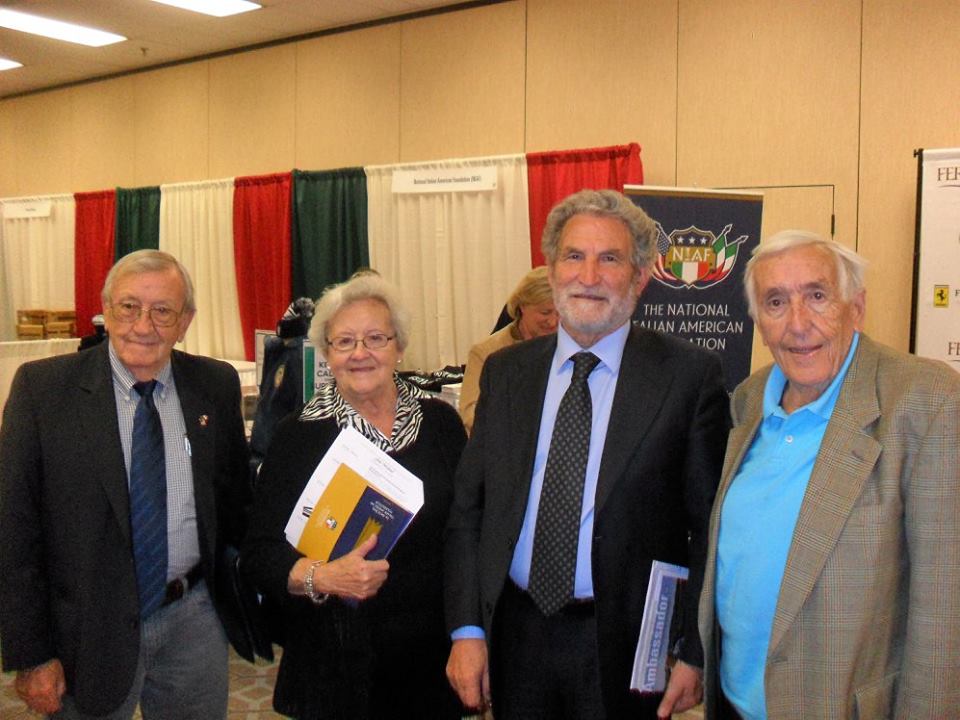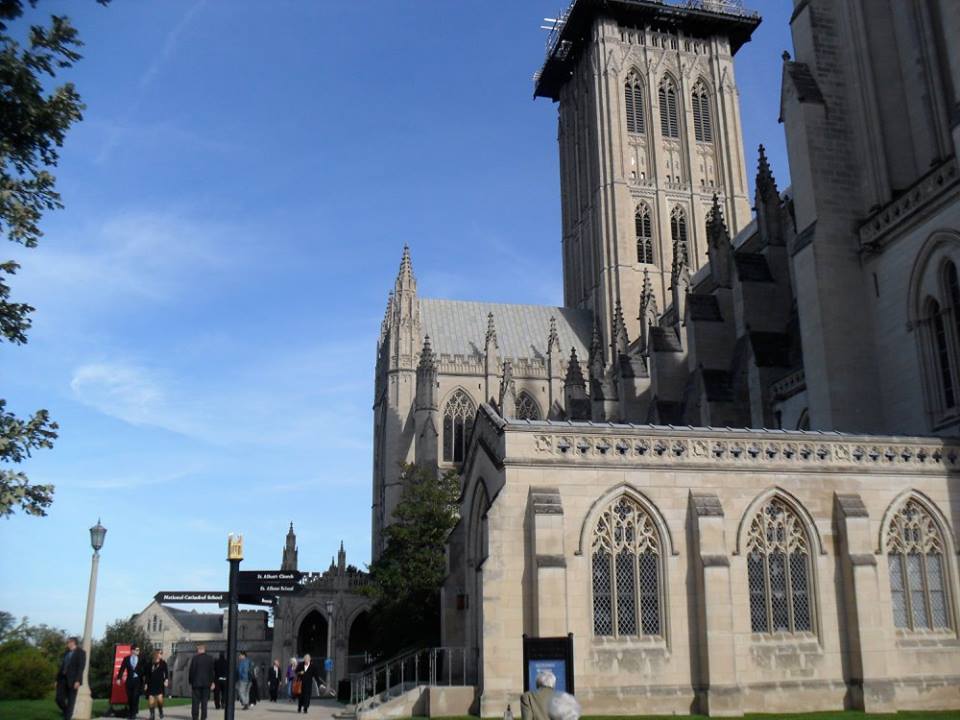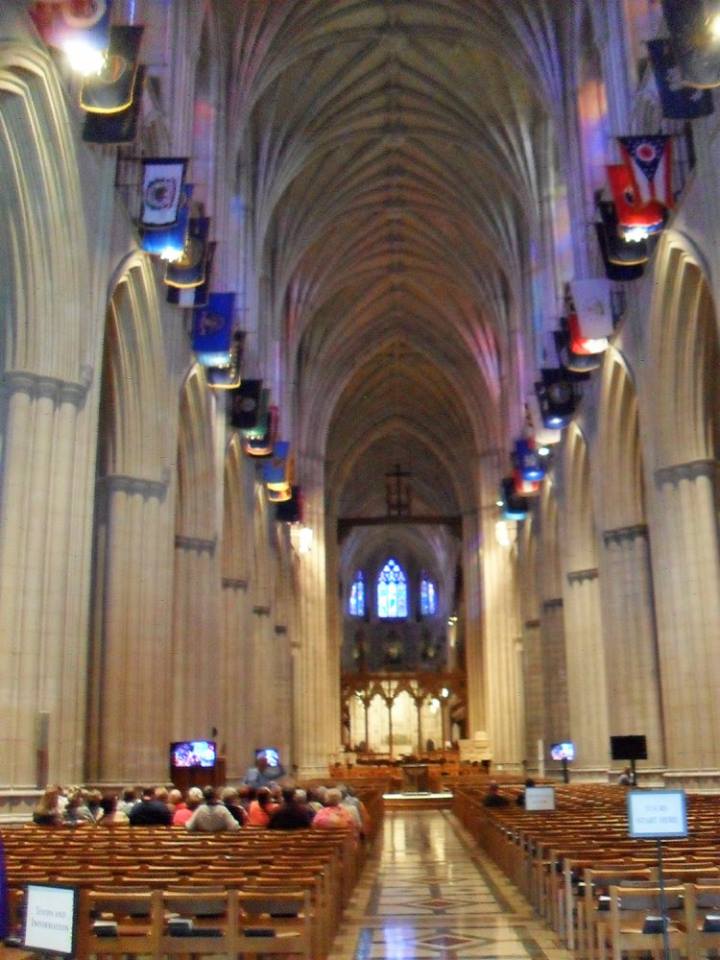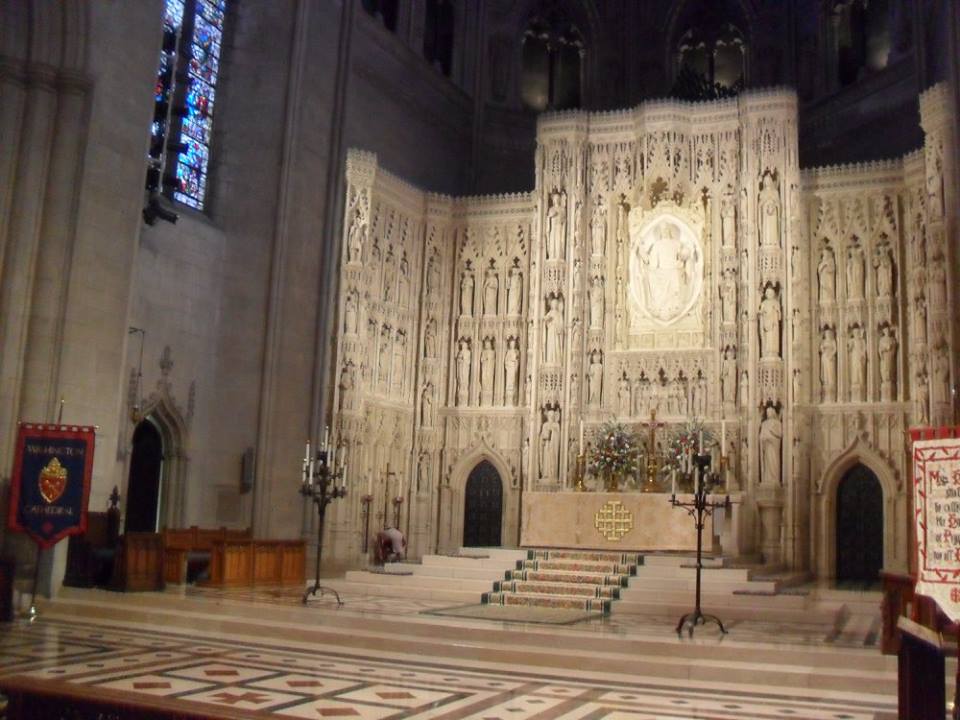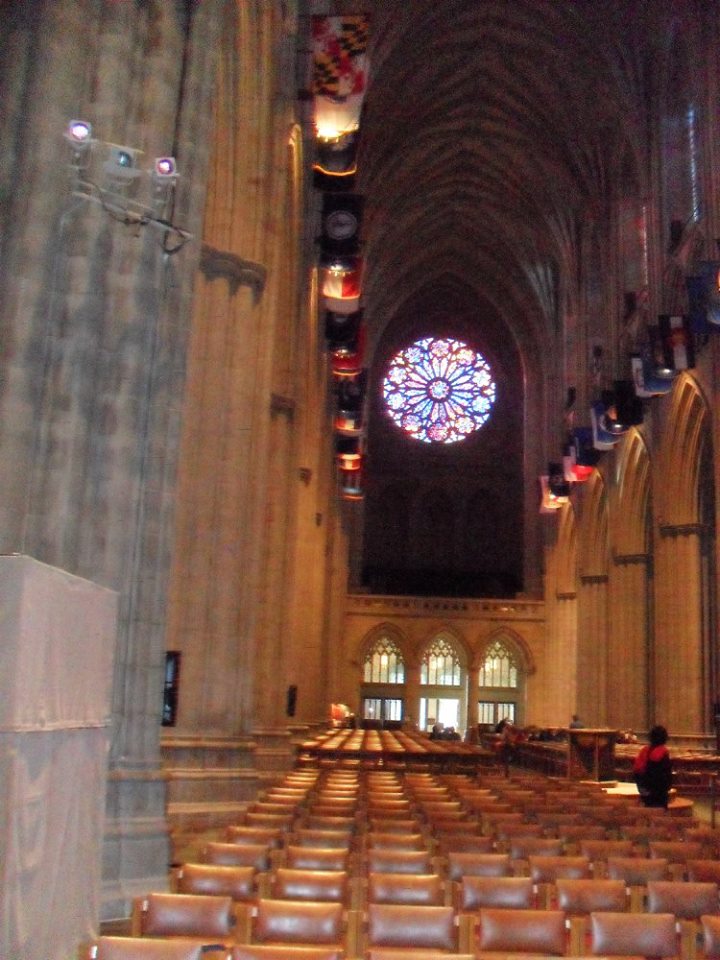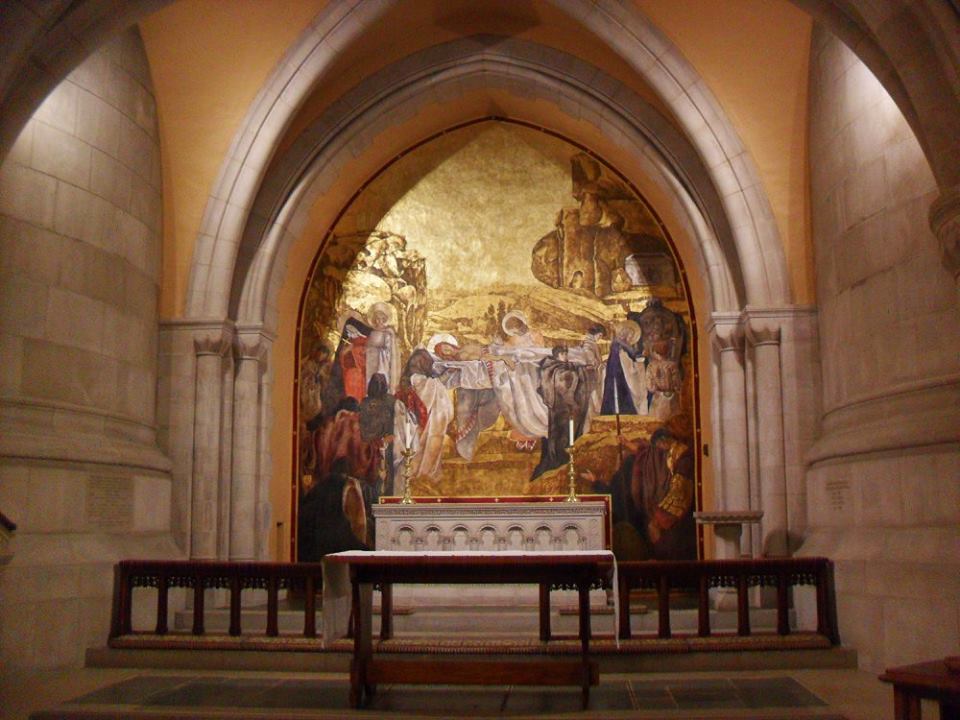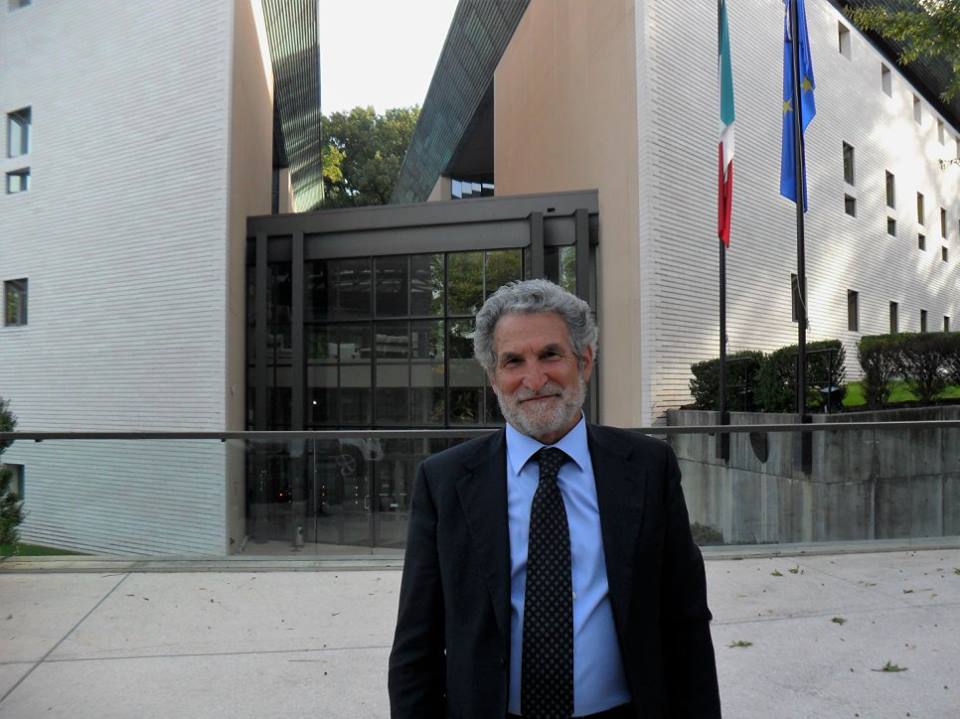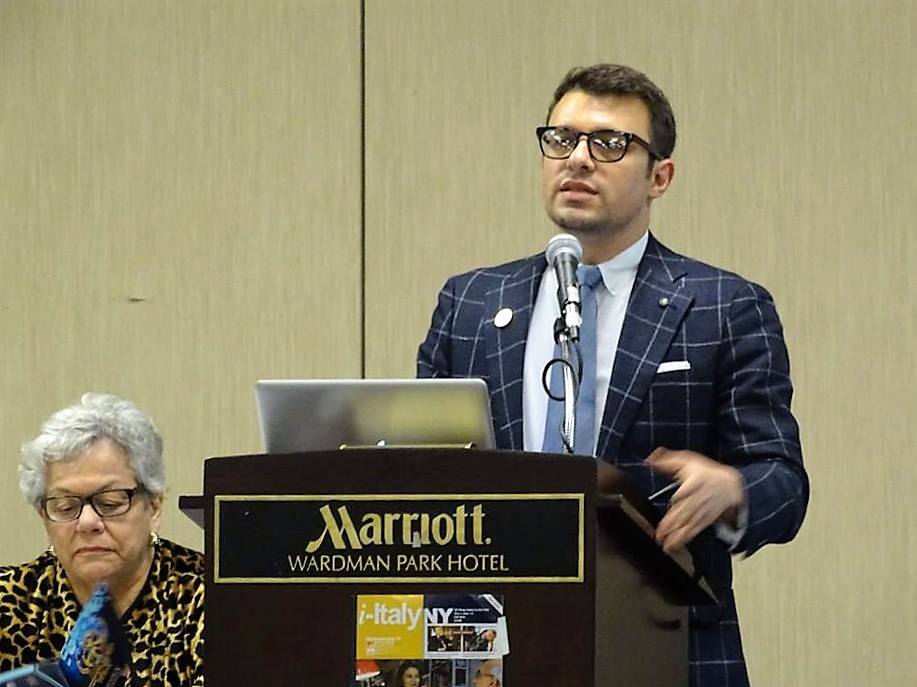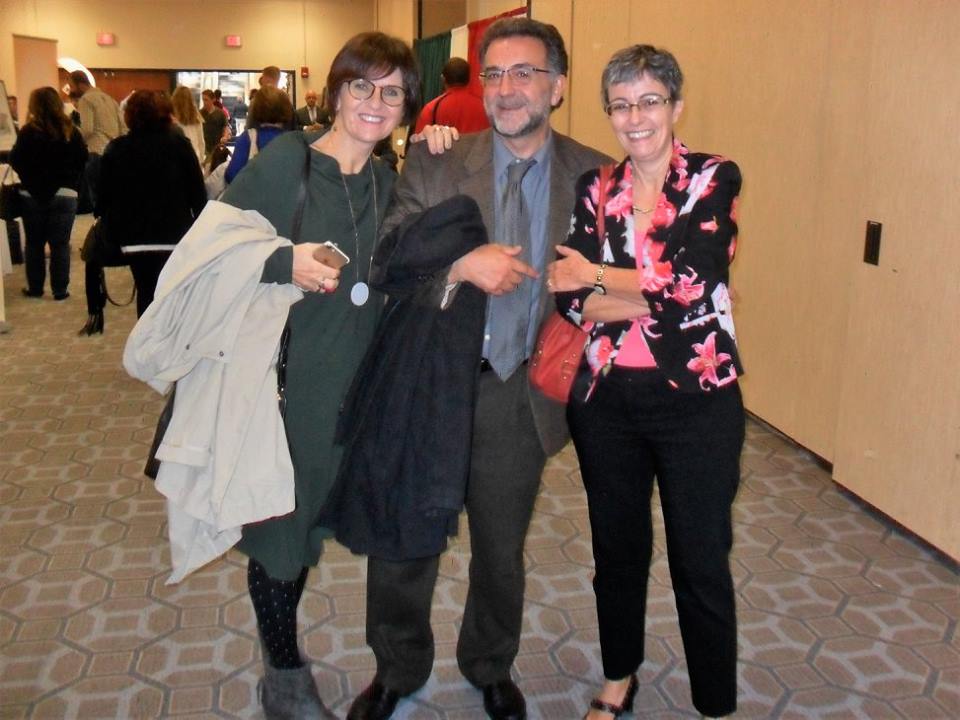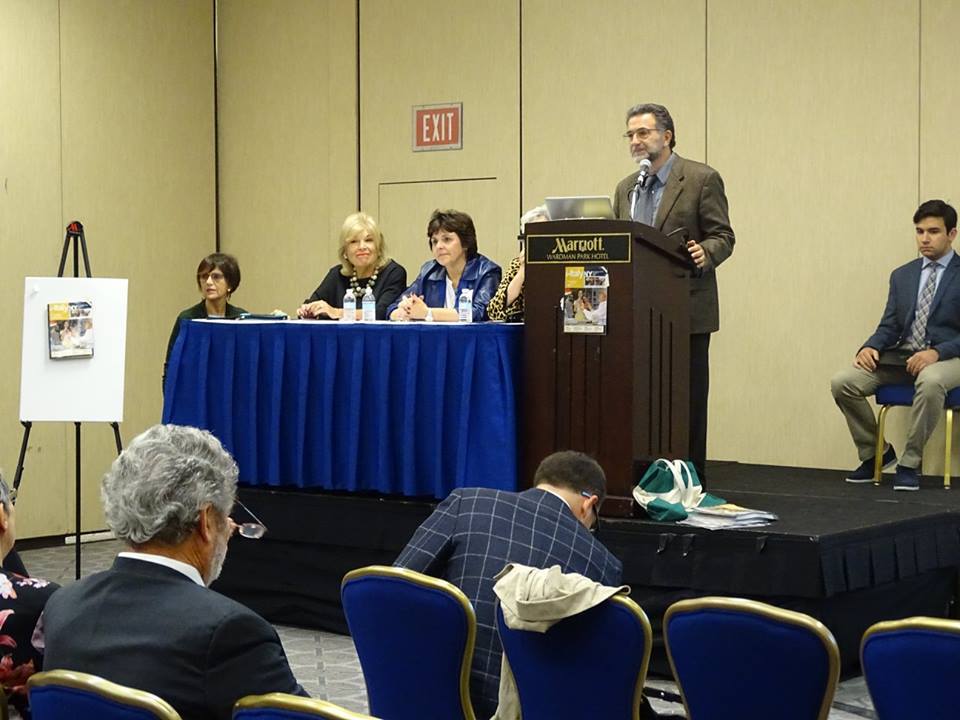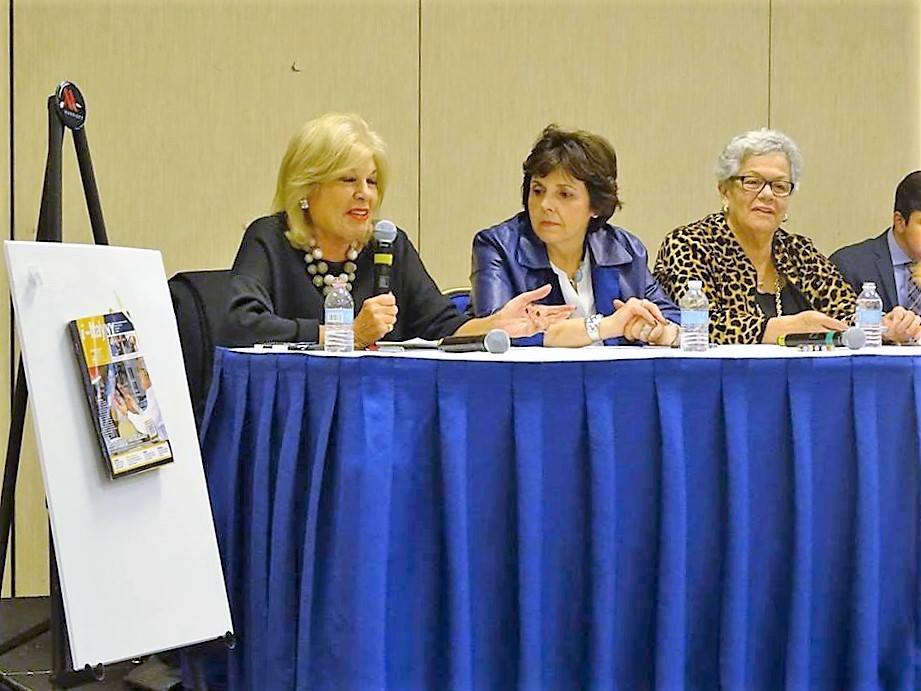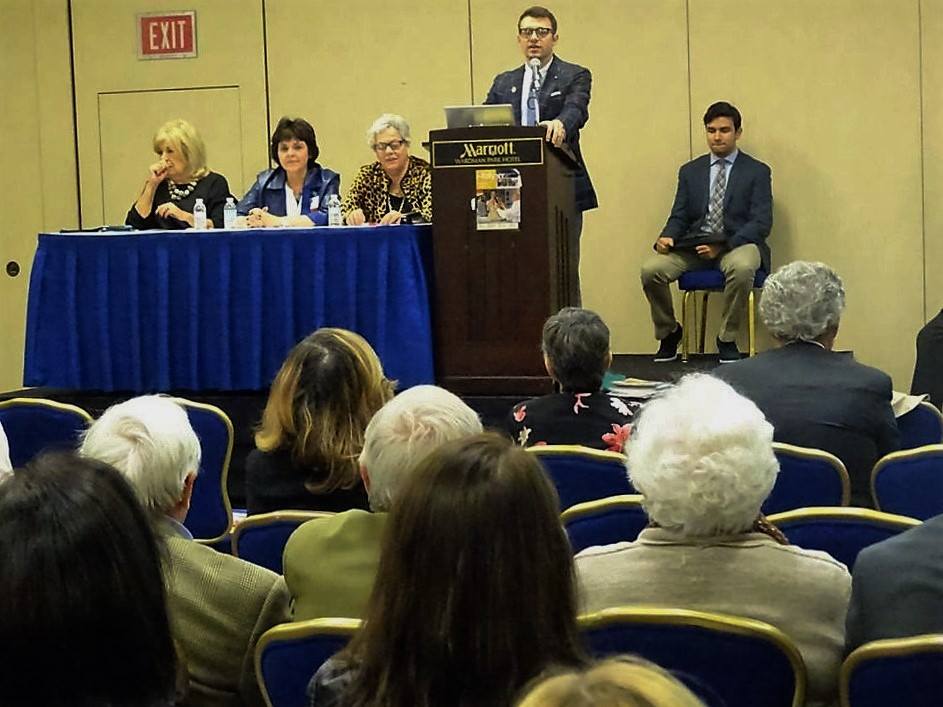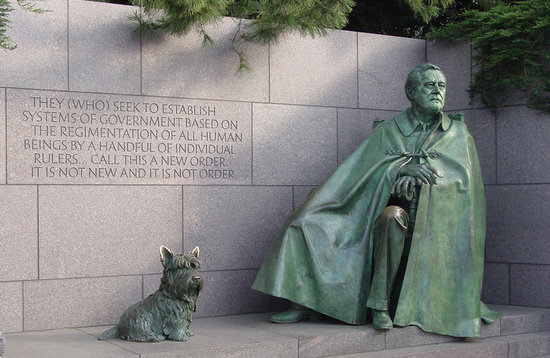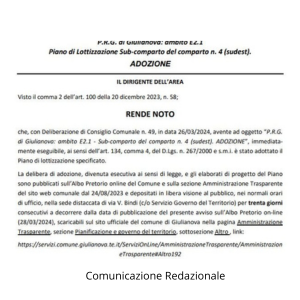22 ottobre 2016
REPORTAGE DAGLI STATES: LE TRE INTENSE GIORNATE DI WASHINGTON
La serata speciale con l’AMHS, la visita alla Georgetown University, gli incontri al Gala Weekend NIAF
di Goffredo Palmerini
L’AQUILA – Il rientro nella propria città dopo due settimane all’estero è sempre piacevole, quando la tua terra madre t’accoglie con il profluvio delle chiome degli alberi dai cangianti colori dell’autunno, impareggiabile tavolozza d’espressioni cromatiche. E la tua città all’orizzonte, indorata dal tramonto incipiente e trapuntata da innumerevoli sagome di gru all’opera. E poi la nostra montagna, sua maestà il Gran Sasso d’Italia, che si staglia con la sua mole possente già imbiancata di neve sull’azzurro intenso e nitido del cielo. Ora però è tempo di raccontarle queste due straordinarie settimane di missione negli States, a New York e Washington. E cominceremo proprio da Washington – doveroso rispetto alla Capitale – con le tre intense giornate del 13, 14 e 15 ottobre.
Il 13 ottobre, giovedì. E’ una bella giornata di sole, ma ancora fresca, quando alle 7 e mezza uscendo m’avvio in subway nei pressi di Pennsylvania Station. Da là parte il bus Vaamose che mi porterà a Washington. Anzi nei pressi, a Bethesda. Trovo gente che già aspetta. Bagagli ordinati in fila sul marciapiede della 7^ Ave, un addetto che sul tablet spunta il nome dei viaggiatori. Dieci minuti prima dell’orario di partenza arriva l’autobus. Si sale. Alla guida un signore austero, barba fluente e kippah in capo. Lo zucchetto rivela le sue origini ebraiche. Prendo posto in prima fila, ho tutta la strada sotto i miei occhi. Alle 8:30 in punto si parte, scendendo lungo la Settima, con il sole che da sinistra comincia a penetrare tra i profili dei grattacieli. Dopo l’incrocio con la 12^ Strada la svettante sagoma dell’One WTC si para di fronte con i primi riverberi del sole sui suoi vetri. Il grattacielo, il più alto della Grande Mela, è l’erede delle Twin Towers, il simbolo del coraggio, dell’orgoglio e della rinascita dopo la tragedia dell’11 settembre 2001. Ancor giù, dopo il toro bronzeo di Wall Street, l’autobus infila l’Holland Tunnel, passando sotto l’Hudson River, per riemergere a Jersey City, sull’altra riva del fiume. Sulla sinistra, in lontananza, stende il braccio con la sua torcia la Statua della Libertà. Passato l’aeroporto di Newark già si corre sull’interstate 95, la lunga arteria che collega il nord e il sud dell’America.
Lasciati i centri abitati si marcia spediti, a 65-70 miglia orarie, tra due sponde rigogliose di alberi fronzuti, una lunga teoria di verde che s’interrompe sul Deleware Memorial Bridge, lungo ponte di ferro che scavalca l’omonimo fiume. Scorrevole il traffico, sebbene vi si snodi una serpentina di truck, quei giganti delle strade americane. Trenton, Philadelphia, Atlantic City, Wilmington, sfilano le uscite per quelle città. E già s’annuncia Baltimora. Eccola da lontano, con i grattacieli della City e il suo porto, mentre la strada s’insinua nell’Harbor Tunnel. Manca ormai poca strada per Bethesda. Alle 12:30 l’arrivo, nel centro di questa graziosa città del Maryland che dista una manciata di chilometri da Washington. Vi abita un’aquilana illustre, Laura Benedetti, venuta qui, dopo aver insegnato ad Harvard, per assumere la docenza di Letteratura italiana presso la Georgetown University. In questo prestigioso ateneo della capitale federale ha poi diretto per sei anni il dipartimento di studi italiani. Mi viene a prendere alla fermata. Sono onorato, è un privilegio averla come guida, speciale e premurosa, in questi tre giorni di missione a Washington.
Nel primo pomeriggio subito una visita a Georgetown. Ateneo privato prestigioso, è la più antica università cattolica degli Stati Uniti, fondata nel 1789 dal gesuita Padre John Carroll, la cui statua bronzea si trova appena dopo l’ingresso centrale. Belle le spiccate architetture dell’antico edificio in pietra squadrata, cui fanno da pendant le forme moderne dei nuovi edifici. Strutture sportive, parchi, biblioteche, una cappella e perfino un piccolo cimitero dove riposano i padri gesuiti passati per l’università, s’articolano nella mappa degli edifici destinati all’insegnamento e allo studio. L’ateneo è una piccola città autonoma, dove gli studenti esterni e quelli ammessi dopo rigorosa selezione al Campus interno, circa 15.000, vivono i loro studi in una dimensione di serenità, di benessere, d’efficienza nelle strutture e d’eccellenza nei servizi. E ancora nella qualità dell’insegnamento, che dell’ateneo è il vero prestigio. Tranquilla, questa parte di capitale, perché l’università – che prende il nome dell’antico borgo e poi quartiere -, è contornata tuttora da piccole case monofamiliari dipinte in colori pastello, protette dal vincolo architettonico che le tutela da invadenze dell’edilizia moderna, che tuttavia a Washington ha i contorni della moderazione e della gradevolezza delle forme.
Laura Benedetti mi accompagna alla scoperta dell’ateneo, guidandomi nel palazzo antico dove sono gli uffici del Rettore, anzi del President nella definizione americana. A guidare la Georgetown dal 2001 è John J. De Gioia, 48° presidente e il primo “laico” nella storia dell’ateneo, sempre diretto da un padre gesuita. Laura mi accompagna fin quasi alla soglia della stanza del Presidente, chiedendo all’ossequiosa segretaria il permesso di farmi visitare l’auditorium, la sala delle riunioni, la storica biblioteca con volumi preziosissimi ed altri ambienti ricchi di memoria. Quindi la visita al dipartimento italiano, attualmente diretto dalla prof. Anna De Fina, alla quale Laura mi presenta e con lei teniamo un breve colloquio. Il dipartimento, e i suoi docenti, sono una punta avanzata della cultura italiana a Washington, con importanti attività ed eventi, condotti sovente in stretta collaborazione con l’Istituto italiano di Cultura e l’Ambasciata d’Italia. Non posso qui non ricordare l’assiduità con la quale la prof. Benedetti ha promosso e organizzato negli anni passati numerose Summer School in Italia – e nella nostra città – in partnership con l’Università dell’Aquila. E mi auguro che questa consuetudine possa continuare proficuamente negli anni a venire, trovando significativa e feconda la collaborazione tra le due università. Infine, la visita si conclude nel moderno edificio della Lauinger Library, nel salone dove si sta per tenere una seduta del Senato accademico. Entriamo qualche minuto per godere dall’ampia vetrata una davvero straordinaria vista sul Potomac e sulla sponda da cui inizia il territorio della Virginia.
Alle 4 e mezza lasciamo l’ateneo per recarci proprio in Virginia, ad Alexandria, in casa di Omero Sabatini, altro aquilano di vaglia. Diplomatico in pensione del governo federale Usa, ministero dell’Agricoltura, Omero ha una densa biografia di rappresentanze ufficiali all’estero e di pubblicazioni scientifiche. Nella sua abitazione, in una tranquilla zona residenziale della città, ci aspettano lui e sua moglie Belinda, ma anche Lucio D’Andrea e signora Edvige, e Nancy De Santi. Lucio D’Andrea, molisano, ingegnere petrolifero, è stato promotore nel giugno 2000, con Omero Sabatini e altri, della costituzione dell’Abruzzo & Molise Heritage Society (AMHS), l’associazione cui fanno capo gli abruzzesi e molisani del District of Columbia, l’area della capitale, e dei confinanti stati del Maryland e Virginia. Del sodalizio è attualmente presidente Maria D’Andrea-Yothers, dirigente del dipartimento per il Commercio del governo federale e già componente del Segretariato dell’Organizzazione mondiale del Commercio a Ginevra. E’ figlia di Lucio, presidente emerito dell’AMHS insieme ad Omero. Ho avuto possibilità di conoscere Omero nel 2008 a L’Aquila, in casa del fratello Bruno – medico, scrittore, pittore, amante della musica e della montagna – con il quale ho un forte rapporto di amicizia. Con Omero Sabatini parliamo anche di un’interessante traduzione e riduzione del romanzo “I promessi sposi” di A. Manzoni, diventato “Promise of Fidelity”, della quale egli è autore, pubblicata nel 2002 negli Usa. Il volume ha incontrato l’apprezzamento dei lettori americani, per l’agevole comprensione della storia narrata nel romanzo manzoniano.
L’incontro con i componenti del Consiglio direttivo dell’AMHS si tiene in una sala riservata di un ottimo ristorante siciliano ad Arlington. Ho accettato volentieri, quest’anno, l’invito a visitare la comunità abruzzese e molisana dell’area di Washington. M’informo nel corso dell’incontro sull’associazione e sulle numerose attività sociali e culturali che realizza. Poi parliamo dell’Aquila, dello stato della ricostruzione della città dopo il terremoto del 2009. Li rinfranco sui progressi della ricostruzione, molto avanzata – oltre il 90 per cento – quella esterna alle zone rosse, abbastanza avviata quella del centro storico del capoluogo, mentre solo ora sta iniziando nei centri storici delle frazioni. La ricostruzione a L’Aquila sta restituendo un centro storico di straordinaria bellezza, circondato dai 6 chilometri e mezzo delle antiche mura urbiche anch’esse restituite, con le 12 porte, al loro splendore. L’Aquila, tra le più belle città d’arte d’Italia, sarà tra qualche anno una vera meraviglia. Certo, ci sono anche ombre nella ricostruzione, che la magistratura va accertando e censurando, ma nel complesso, dopo i primi anni problematici, nel 2012, grazie al pluriennale programma di finanziamenti assicurato dai governi Monti e Renzi, la ricostruzione è finalmente decollata. Questi riferimenti li rinfrancano, essendosi loro fatta un’idea diversa dalle notizie spesso inesatte che sovente passano attraverso i mezzi d’informazione, prive di attualità nei riscontri. Altri riferimenti fornisco sulla situazione di Amatrice, Accumoli, Arquata e Pescara del Tronto, colpite dal terremoto del 24 agosto 2016, per le quali popolazioni il sodalizio sta raccogliendo aiuti.
La riunione va volgendo al termine quando Lucio D’Andrea, quale presidente emerito dell’AMHS – la presidente Maria D’Andrea-Yothers aveva un impegno in NIAF -, inopinatamente mi consegna una pergamena con la nomina a Socio onorario. Sono commosso per questo gesto di considerazione, ancor più sorpreso nell’apprendere che è stato finora riservato solo a cinque personalità tra le quali il Giudice della Corte Suprema degli Usa Antonin Scalia e l’Ambasciatore Luigi Einaudi, già Segretario generale dell’Organizzazione degli Stati Americani presso le Nazioni Unite. Esprimo la mia gratitudine con un intervento che sottolinea il valore e il contributo dell’emigrazione italiana nella scrittura della grande Storia del nostro Paese. Non sempre questo viene affermato, come si dovrebbe, anche per la superficiale conoscenza che si ha della storia delle migrazioni italiane nel mondo, talvolta infarcita di stereotipi. Ancor più grave questo limite quando si riscontra presso la classe politica. Il mio ringraziamento va ai nostri emigrati non solo per il contributo reso alla rinascita dell’Italia, specie nel secondo dopoguerra, ma sopra tutto per aver testimoniato, con le loro capacità e il loro talento, le vere qualità degli italiani in Paesi dove talvolta permangono diffidenze e pregiudizi verso l’Italia. Qual è davvero l’Italia, allora, la si conosce proprio attraverso le testimonianze di vita degli 80 milioni d’italiani che vivono nel mondo, l’altra Italia che dovrebbe essere conosciuta e riconosciuta in Patria. Quindi la mia gratitudine, espressa in forma comunitaria in ragione d’un lungo servizio che ho reso nelle istituzioni. Dunque, una bella serata d’amicizia e d’emozioni condivise, nella comunanza delle nostre radici d’origine e culturali.
La mattinata di venerdì 14 la dedichiamo a Bethesda. Prende il nome dall’omonima chiesa presbiteriana edificata nel 1820 e dalla biblica piscina in Gerusalemme. Interessante la passeggiata con Laura per conoscere da vicino la città: 60mila abitanti circa, bella davvero, immersa nel verde. Spesso alberi secolari s’incontrano nei suoi parchi, mentre piante e fiori colorano le sue strade. Ma è l’immersione nel bosco, nel Capital Crescent Trail, che mi emoziona. Un sentiero dove si va in bici o per il footing, che scende fino al fiume Potomac. Ma è il sentiero che Alice, protagonista del bel romanzo “Un paese di carta” – la prima incursione di Laura Benedetti nella narrativa, come autrice -, percorre nel racconto per andare a spirare sulla riva del fiume. Il romanzo narra tre generazioni di donne. La prima è quella di Alice, emigrata dall’Abruzzo nel secondo dopoguerra e bibliotecaria a Bethesda. Le vicende del romanzo, nell’intreccio tra Alice, sua figlia Jane e la nipote Sara, si svolgono tra Maryland, Utah e infine l’Abruzzo, a L’Aquila devastata dal terremoto, dove Sara va a disperdere le ceneri della nonna. Con le sorprendenti scoperte sulla vita antecedente di lei, nei tragici giorni dell’occupazione tedesca e della sua partenza improvvisa per gli Stati Uniti, appena dopo la fine della guerra.
All’una del pomeriggio Laura m’accompagna in macchina a Washington, al Marriott Wardman Park hotel. Là si svolge il 41° Gala Weekend della National Italian American Foundation (NIAF) che dal 13 tira fino al 16 ottobre. M’incontro con Lucio D’Andrea e con suo fratello Joseph, venuto da Pittsburgh dove è stato Console onorario d’Italia e Consigliere comunale. Molisano di Roccamandolfi, nato nel 1930, emigrato in Usa nel ’48, lauree in Lingue ed Economia, ha lavorato come interprete presso il ministero della Giustizia. A lui si deve un forte impulso a far luce, a quasi un secolo dall’evento, sulla tragedia di Monongah, in West Virginia, nell’esplosione e l’incendio della miniera di carbone avvenuta il 6 dicembre 1907, dove persero la vita quasi mille persone, benché la cifra ufficiale fosse molto inferiore. Tra le vittime 171 italiani, di cui 87 molisani ed una trentina di abruzzesi. Nel 2007, ricorrenza centenaria della tragedia, a cura di Joseph D’Andrea veniva pubblicato il volume “Monongah cent’anni d’oblio”, una puntigliosa ricerca su quel terribile fatto e sulle vittime molisane del disastro. Finalmente, proprio ad un secolo dalla tragedia, anche l’Italia finalmente rendeva onore alle vittime di Monongah, il doveroso tributo del Paese a quei figli emigrati periti nella miniera. Era stata necessaria un’intensa campagna di stampa condotta dal direttore del quotidiano La Gente d’Italia, Domenico Porpiglia, a riaccendere l’attenzione sul caso e finalmente a smuovere le istituzioni italiane. Con Joseph abbiamo anche parlato dei due giovani universitari che la comunità italiana di Pittsburgh “adottò” nel 2009 dopo il terremoto dell’Aquila. Joseph mi chiese i nomi di due studenti d’Ingegneria dell’Università dell’Aquila, un abruzzese e un molisano, ai quali gli italiani di Pittsburgh avrebbero assicurato le spese d’ospitalità, mentre l’Università di Pittsburgh li avrebbe accolti nella medesima Facoltà. Mi rivolsi alla prof. Anna Tozzi, responsabile dei rapporti internazionali dell’Università dell’Aquila, che provvide celermente a scegliere i due studenti con un avviso pubblico. Quel fatto ha portato fortuna a Luca, molisano, e a Berardo, abruzzese di Teramo. Il primo sta studiando a Pittsburgh per il dottorato, Berardo invece già lavora in Olanda per un’importante società multinazionale.
Mentre parlo con Joseph si avvicina per salutarlo John Viola, il giovane presidente della NIAF. Mi congratulo con lui per la sua tenace opera alla guida della prestigiosa Fondazione degli italoamericani. Incontro e saluto poi il prof. Anthony J. Tamburri, direttore del Calandra Institute della City University di New York. Tra l’altro mi annuncia che prossimamente verrà a L’Aquila con una delegazione per consegnare alla Municipalità 10mila dollari destinati ad un’iniziativa di ricostruzione nella città. Restiamo d’intesa che mi comunicherà per tempo la data della visita, volentieri darò ogni collaborazione. Altri incontri nel pomeriggio, con Umberto Mucci e Melo Cicala, e un veloce saluto a Tony Renis che nel concerto della serata riproporrà alcuni celebri suoi brani. In macchina, con Joseph e Lucio D’Andrea, Edvige e Luca, si va a visitare la National Cathedral, il magnificente duomo della capitale. Non solo una splendida chiesa cristiana, ma anche un impareggiabile luogo di concerti e d’esposizioni d’arte. Realizzato in pietra dell’Indiana, il tempio è a croce latina, imponente, tra i primi sei al mondo per dimensioni, con una navata centrale lunga 161 metri. Architettura gotica, svettante, con diversi rosoni in pietra ornati da splendide vetrate e varie opere in ferro battuto, vetro colorato e tessuti. Finemente lavorato il Coro ligneo dietro l’altare centrale, suggestiva la cripta sottostante. I lavori di costruzione della Cattedrale, dedicata ai Santi Pietro e Paolo, iniziarono nel 1907 con la prima pietra posata dal presidente Theodore Roosevelt. Nel 1990 la posa dell’ultima pietra a cura del presidente George H.W. Bush. Attualmente vi sono lavori in corso per la riparazione dei danni del terremoto del 23 agosto 2012 – magnitudo 5,9 della scala Richter – che danneggiò il tetto e fece crollare alcuni pinnacoli, ancora non ricollocati e al momento adagiati in un lato del sagrato. Completata la visita in cattedrale facciamo un salto all’Ambasciata d’Italia, su Whitehaven Street. Ammiro le bianche forme architettoniche e la simbologia dell’opera, progettata dall’architetto Piero Sartogo.
Alle sei di sera si torna a casa di Laura. Al nostro rientro Brad ha acceso il fuoco in camino e aperto una buona bottiglia di vino rosso francese. Brad Marshall è direttore del programma di Lingua francese presso la George Washington University. L’ho conosciuto qualche anno fa a L’Aquila, venuto per una vacanza con sua moglie Laura e con Martina, la loro figlia che ora studia a Georgetown, residente nel Campus dell’università. Una bella serata, una buona cena, poi una visita in notturna ai monumenti simbolici della Capitale, ai Memorials. S’inizia dal Franklin Delano Roosevelt Memorial, un suggestivo percorso monumentale per ricordare uno dei più grandi presidenti degli Stati Uniti d’America, cui si deve l’uscita dalla grande depressione del 1929, l’unico ad essere eletto in quattro mandati consecutivi, dal 1932 al 1945, e deceduto all’inizio del suo ultimo mandato. Un presidente illuminato che ispirò leggi sociali importanti, dando peraltro avvio a quel grande piano d’investimenti che va sotto il nome di New Deal, oltre a guidare il Paese negli anni difficili della seconda Guerra Mondiale. Nel granito del Memorial sono incise le sue frasi più celebri e significative. Commoventi. Seguono le visite al Jefferson Memorial, al Lincoln Memorial, al National Mall, l’obelisco in memoria di George Washington, al Capitol Hill, il Campidoglio, dove hanno sede il Senato e il Congresso degli Stati Uniti. Ancora un giro per ammirare velocemente gli esterni dei numerosi Musei che contornano l’area dei Memorials e infine la Casa Bianca. Una breve ma intensa immersione nei simboli della grande Storia degli Stati Uniti d’America.
Ultimo giorno a Washington, sabato 15 ottobre. Arriviamo con Laura alle 11 di mattina al Marriott per seguire un importante evento: la presentazione del progetto multimediale “Grandparents and Granchildren in Italian America”, prodotto da i-Italy TV e ANFE, con il sostegno del Ministero degli Affari Esteri – Direzione generale per gli Italiani all’estero. Si tratta della presentazione del primo gruppo d’interviste tra nonni e nipoti nell’America italiana, in particolare le conversazioni tra Matilda Raffa Cuomo e Amanda Cole; Joseph Tusiani e Paola Tusiani; Aileen Riotto Sirey ed Emma Banker; Rosaria Liuzzo e Mara Sparacino; John P. Calvelli e John D. Calvelli. Nato da un’idea di Gaetano Calà, direttore generale ANFE, Letizia Airos e Ottorino Cappelli, rispettivamente direttore ed editore del prestigioso network i-Italy (Tv, testata on line inglese/italiano e magazine bimestrale in lingua inglese), il progetto affronta il mondo dell’emigrazione italiana in America attraverso interviste con le sue più affermate personalità nei diversi campi d’impegno. Delle interviste in progetto questa è solo una prima serie. Alle 11:30, dopo la trasmissione d’un video con brani d’interviste, stupendi spot che promuovono la lingua italiana ed altri contributi, Ottorino Cappelli introduce l’evento, presentando il panel dei relatori composto da Patricia De Stasi Harrison, Linda Carlozzi, Aileen Riotto Sirey. Moderatore il giovane John D. Calvelli. Il presidente della NIAF John Viola porta il saluto della Fondazione, sottolineando la qualità del progetto e l’attenzione che NIAF riserva all’iniziativa. Significativi gli interventi delle tre relatrici, brioso e frizzante il moderatore. Qualificato il pubblico presente all’evento. Dopo la presentazione il colloquio tra Letizia Airos, Ottorino Cappelli e Laura Benedetti. La testata presto aprirà una redazione a Washington, successivamente anche in altre grandi città degli States. La prelazione è verso giovani talenti che vogliano operare nel mondo dell’informazione, con particolare cura del linguaggio della comunicazione, cifra del network, rivolto alle giovani generazioni.
Dopo l’evento, girando tra gli stand promozionali nell’ampio corridoio che serve le varie sale dove si tengono i diversi eventi in agenda, molti gli incontri. Il primo con Francesca Alderisi, amica carissima e volto tra i più noti e amati della Rai, nei programmi per gli italiani nel mondo. Attualmente è impegnata in un programma giornaliero tutto suo, “Pronto Francesca”, molto apprezzato. Poi Maria D’Andrea-Yothers, che abbraccio e ringrazio per la calorosa accoglienza ricevuta dall’AMHS. E ancora Cristina Fontanelli, bravissima soprano che mi annuncia il suo concerto prenatalizio, invitandomi a New York. Mi commiato da Joseph D’Andrea, suo fratello Lucio, quindi da Letizia ed Ottorino con la loro splendida équipe di operatori tv. E’ ora di avviarsi per ripartire. Laura mi accompagna a Bethesda a prendere l’autobus delle 14:50. Un abbraccio alla mia straordinaria guida, la concittadina aquilana che ringrazio anche per la concessione di una bella intervista, raccolta per un’elegante rivista culturale abruzzese. Il viaggio di ritorno è spedito. Quando arrivo nei pressi di Newark un’enorme luna piena torreggia sui grattacieli di Lower Manhattan.
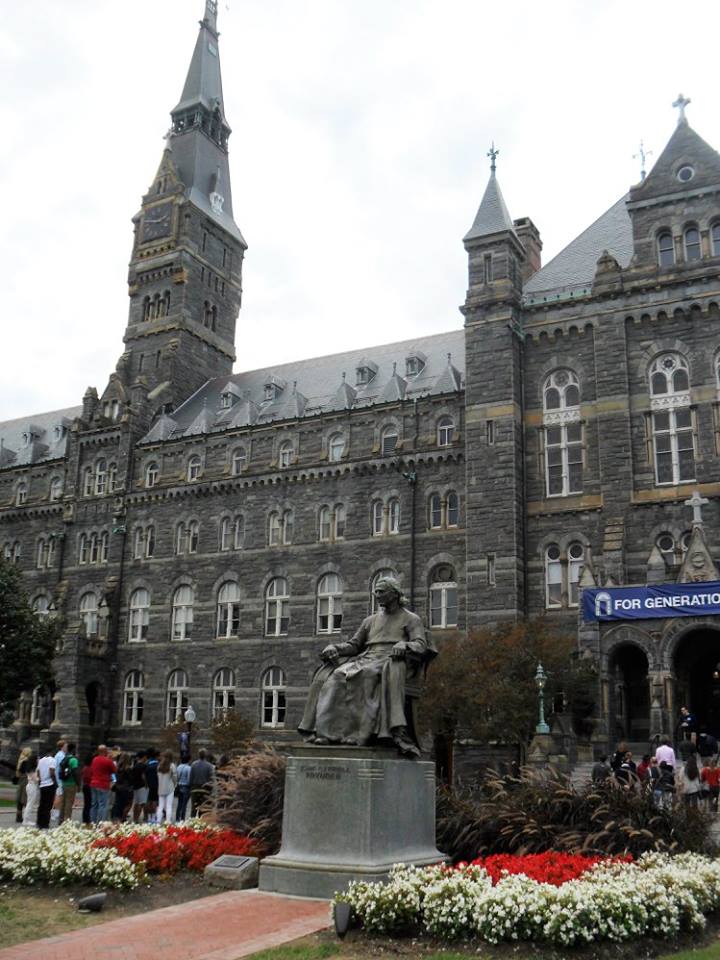
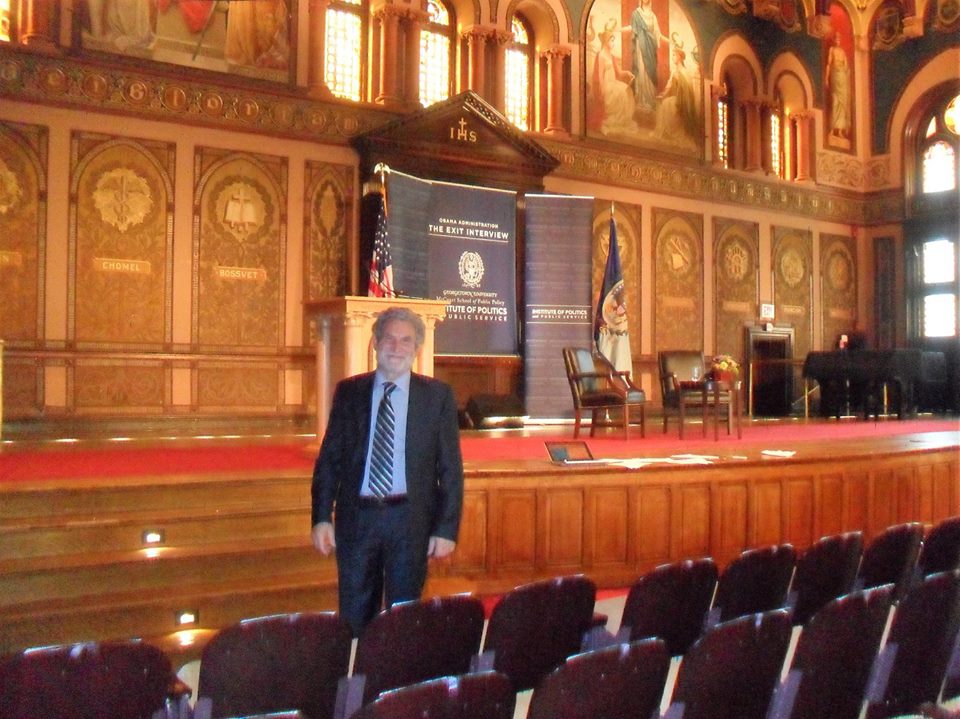
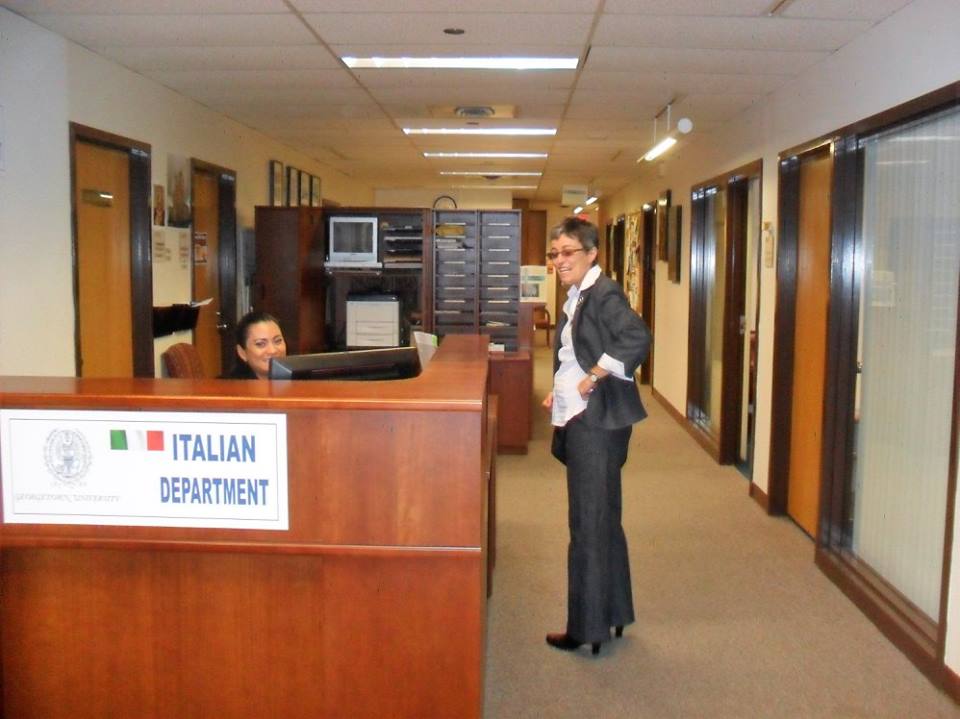
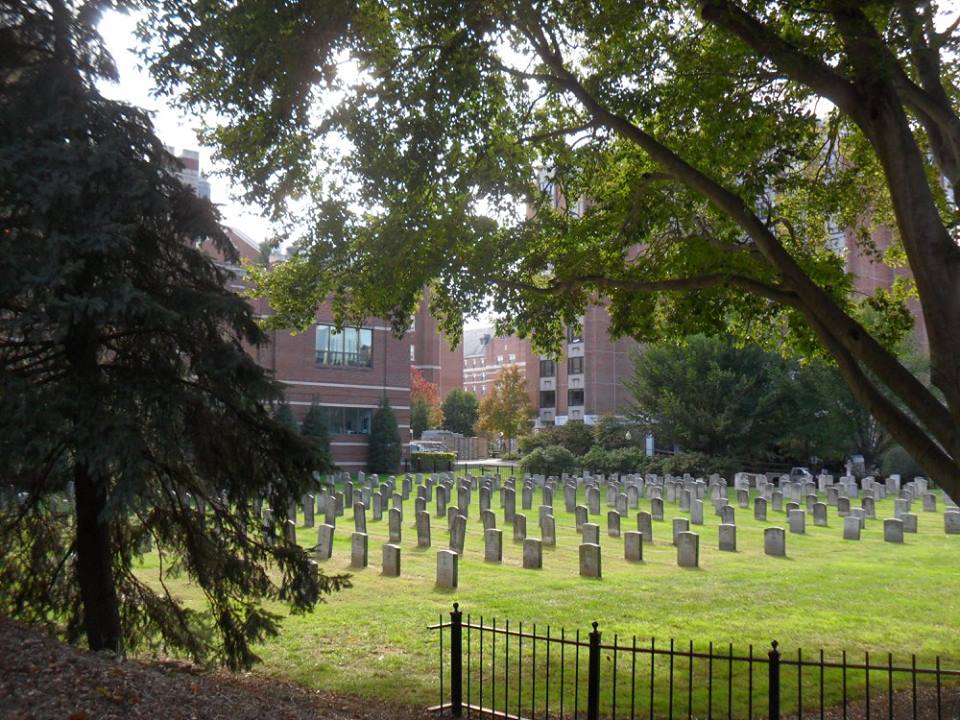
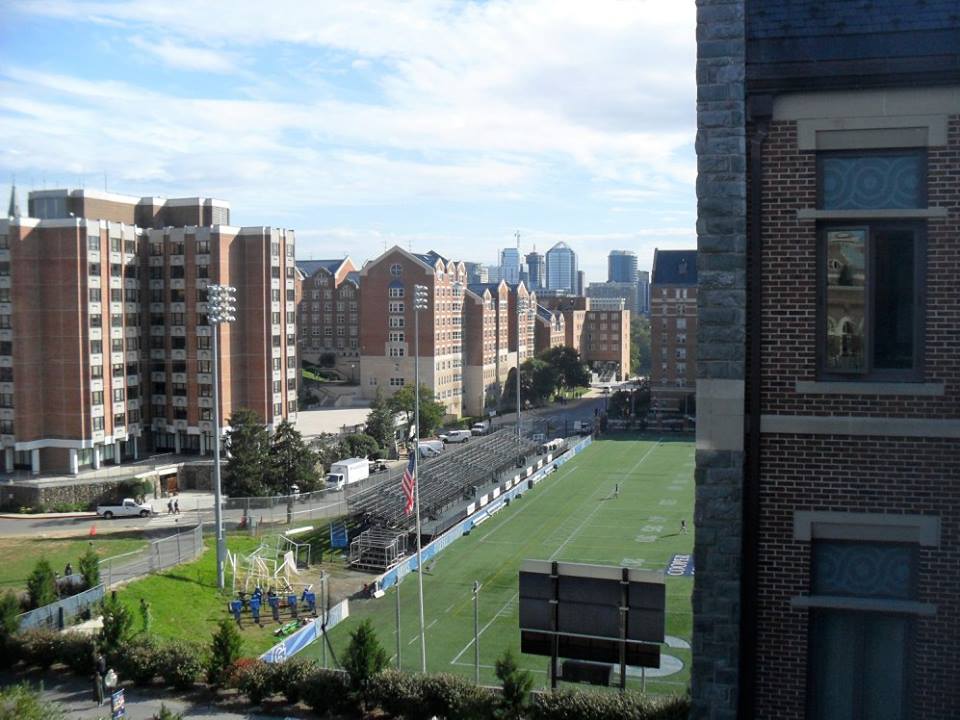
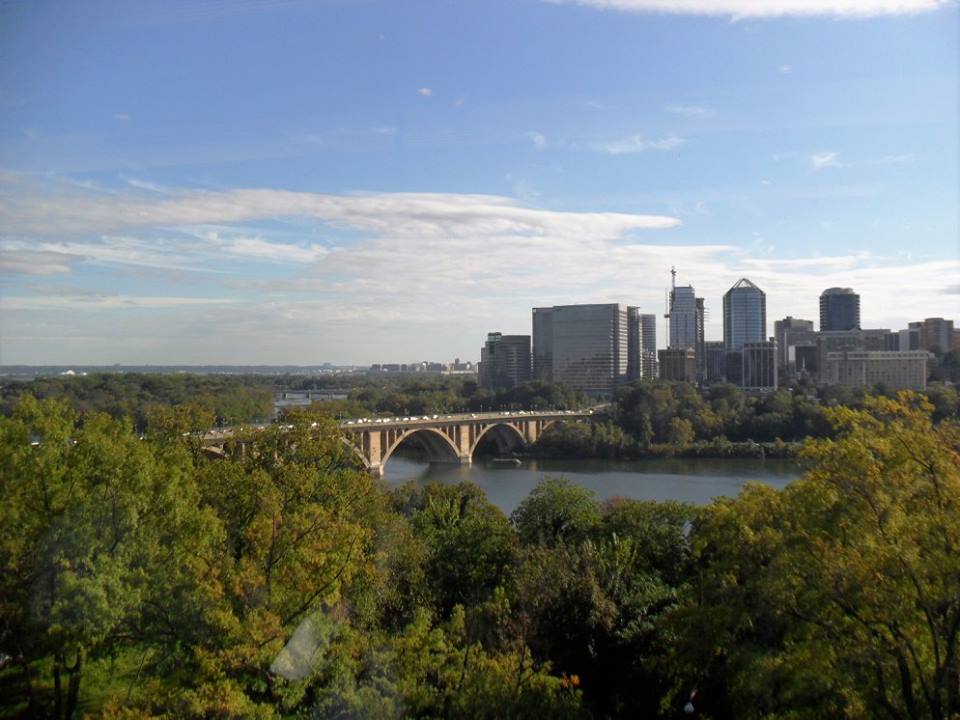
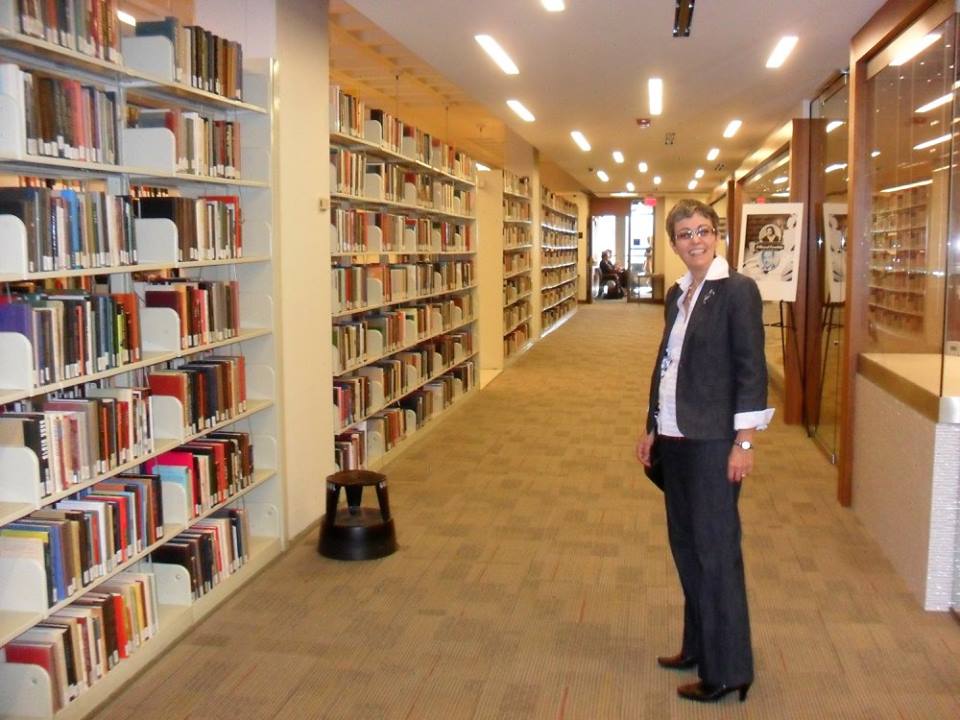
October 22, 2016
REPORTS FROM STATES: THE THREE DAYS OF INTENSE WASHINGTON
The special evening with the AMHS, the visit to Georgetown University, the meetings at the Gala Weekend NIAF
Goffredo Palmerini
L’AQUILA – The return in their city after two weeks abroad is always nice when your native land t’accoglie with the flood of the trees with iridescent colors of autumn, unparalleled palette of color expressions. And your city on the horizon, gilded by the incipient and quilted sunset from the work of countless cranes silhouettes. And then our mountain, his majesty the Gran Sasso of Italy, which stands out with its imposing bulk already whitened snow intense and clear blue skies. But now it is time to tell these two extraordinary weeks of mission to the United States, in New York and Washington. And we will start just from Washington – due respect to the capital – the three intense days of 13, 14 and 15 October.
October 13th, Thursday. It ‘a beautiful sunny day, but still fresh, when the 7 and a half out m’avvio in subway near Pennsylvania Station. From there part Vaamose the bus that will take me to Washington. Indeed near, Bethesda. I find people who are already waiting. Luggage ordered in rows on the sidewalk of the 7th Ave, an attendant who tablet check the travelers’ name. Ten minutes before the departure time the bus arrives. Climb. Driving an austere gentleman, flowing beard and kippah on his head. The skull reveals his Jewish origins. I take front-row seat, I all the way under my eyes. At 8:30 o’clock it start, going down Seventh, with the sun from left begins to penetrate between the profiles of the skyscrapers. After the intersection with 12th Street the towering figure of One WTC you pour in the face with the first reflections of the sun on her glasses. The skyscraper, the tallest in the Big Apple, is the heir of the Twin Towers, the symbol of courage, pride and rebirth after the tragedy of September 11, 2001. Even down after the bronze bull on Wall Street, the ‘bus puts the Holland Tunnel, passing under the Hudson River, to re-emerge in Jersey City, across the river. On the left, in the distance, he is stretching his arm with his torch of the Statue of Liberty. Past the Newark airport already you run on Interstate 95, the long artery that connects the north and south America.
Let the towns are shipped gear, at 65-70 miles per hour, between two lush shores of leafy trees, a long green theory that stops on the Deleware Memorial Bridge, along the iron bridge over the Fulda River. Sliding traffic, although there is a coil of truck hubs, those giants of American roads. Trenton, Philadelphia, Atlantic City, Wilmington, parading the exits to the city. It is already being announced Baltimore. Here it from a distance, with the skyscrapers of the City and its harbor, while the creeps road nell’Harbor Tunnel. Now lacks little way to Bethesda. At 12:30 the arrival, in the center of this pretty town of Maryland which is a few kilometers from Washington. Dwells illustrious un’aquilana, Laura Benedetti, he came here, after teaching at Harvard to take up the teaching of Italian Literature at Georgetown University. This prestigious university in the federal capital has also directed for six years the Italian studies department. I pick me up at the bus stop. I am honored, it is a privilege to have her as a guide, special and thoughtful, in these three days of mission in Washington.
Early in the afternoon once a visit to Georgetown. Prestigious private university, is the oldest Catholic university in the United States, founded in 1789 by Jesuit Father John Carroll, whose bronze statue is located just after the central entrance. Fine the remarkable architecture of the ancient square stone building, which includes a pendant modern forms of new buildings. sports facilities, parks, libraries, a chapel and even a small cemetery where lie the past Jesuit fathers for the university, s’articolano the map of buildings for teaching and study. The university is a small autonomous city, where the external students and those admitted after rigorous selection in the Campus inside, about 15,000, live their studies in a dimension of serenity, wellbeing, efficiency in the structures and excellence in services . And again in the quality of teaching, which is the real prestige of the university. Quiet, this part of the capital, because the university – which is named after the ancient village and then the district – is still surrounded by small single-family houses painted in pastel colors, protected from the architectural constraint that the protection from encroachment of modern building , which, however, Washington has the outlines of moderation and pleasantness of the forms.
Laura Benedetti takes me to the discovery of the university, guiding me in the old building where the offices of the Chancellor, indeed the President in the American definition. Leading the Georgetown since 2001 is John J. De Gioia, 48th president and the first “lay” in the history of the university, also directed by a Jesuit priest. Laura takes me almost to the threshold of the President’s room, asking all’ossequiosa secretary permission to show me around the auditorium, the meeting hall, the historic library with precious books and other rich storage environments. So a visit to the Italian department, currently led by prof. Anna De Fina, to whom Laura introduced me and we keep with her a short interview. The department and its faculty, are a spearhead of Italian culture in Washington, with important activities and events, often carried out in close collaboration with the Italian Cultural Institute and the Embassy of Italy. Here I can not remember the diligence with which the prof. Benedetti has promoted and organized in the past years several Summer School in Italy – and in our city – in partnership with the University of Aquila. And I hope that this practice can continue profitably in the years ahead, finding meaningful and fruitful collaboration between the two universities. Finally, the tour ends in the modern building of Lauinger Library, in the lounge where you are going to hold a meeting of the Academic Senate. We go a few minutes to enjoy a truly amazing view from the large picture window on the Potomac and the shore from where begins the territory of Virginia.
At 4 and a half hours we leave the university with a visit just in Virginia, in Alexandria, home of Homer Sabatini, another order of Aquila. Retired diplomat of the US federal government, the Ministry of Agriculture, Homer has a dense biography of official representations abroad and scientific publications. At his home, in a quiet residential area of the city, waiting for us he and his wife Belinda, but Lucio D’Andrea and Ms. Hedwig, and Nancy De Santi. Lucio D’Andrea, Molise, petroleum engineer, has promoted in June 2000, with Omero Sabatini and others, the constitution of Abruzzo and Molise Heritage Society (AMHS), the association which owns the Abruzzo and Molise in the District of Columbia , the area of the capital, and the neighboring states of Maryland and Virginia. The association is currently President Maria D’Andrea-Yothers, director of the Department of Commerce of the Federal Government and former member of the Secretariat of the World Trade Organisation in Geneva. And ‘daughter of Lucius, president emeritus dell’AMHS along with Homer. I had opportunity to know Homer in 2008 in L’Aquila, in the house of his brother Bruno – doctor, writer, painter, lover of music and mountain – with whom I have a strong friendship. Omero Sabatini we also talk about an interesting translation and reduction of the novel “The Betrothed” by A. Manzoni, become “Promise of Fidelity”, of which he is the author, published in 2002 in the US. The book met with the appreciation of the American players, for easier understanding of Manzoni’s novel narrated in the story.
The meeting with the members of the Governing Council dell’AMHS is held in a room reserved for a great Sicilian restaurant in Arlington. I gladly accepted this year’s invitation to visit the Abruzzo and Molise in the Washington community. Association informs me in the meeting and the many social and cultural activities that realizes. Then we talk about the Eagle, the state of the reconstruction of the city after the earthquake of 2009. They revived on reconstruction progress, very advanced – over 90 percent – the outside to the red zone, rather than the start of the capital’s historic center, while only now it is starting in the historical centers of the villages. The reconstruction in L’Aquila is restoring a historic center of extraordinary beauty, surrounded by 6 km and a half also returned the ancient city walls, with 12 ports, for radiance. L’Aquila, among the most beautiful cities of Italy, will be in a few years a true wonder. Of course, there are also shadows in the reconstruction, that the judiciary should be ensuring and censoring, but overall, after the early problematic, in 2012, thanks to the multi-year funding program ensured by the Monti government and Renzi, reconstruction is finally taken off. These references rinfrancano them, having them made different idea from the news often inaccurate which often pass through the media, with no current in the feedback. Other references I provide on the situation of Amatrice, Accumoli, Arquata del Tronto and Pescara, affected by the earthquake of August 24, 2016, for which populations the association is collecting aid.
The meeting is coming to an end when Lucio D’Andrea, as President Emeritus dell’AMHS – the president Maria D’Andrea-Yothers had a commitment NIAF -, unexpectedly handed me a parchment with his appointment as Honorary Member. I am moved by this gesture of consideration, even more surprised to learn that so far has been restricted to only five personalities including the Judge of the Supreme Court of the United States Antonin Scalia and Ambassador Luigi Einaudi, former Secretary-General of the United Americans at the United Nations. I express my gratitude with a speech underlining the value and contribution of Italian emigration in the writing of the great history of our country. This is not always stated, as you should, even for the superficial knowledge we have of the history of Italian migration in the world, sometimes riddled with stereotypes. Even more severe when this limit is found at the political class. My thanks go to our emigrants, not only for the contribution made to the rebirth of Italy, especially after World War II, but above all for having testified, with their skills and their talents, the true qualities of the Italians in countries where sometimes persist mistrust and prejudice against Italy. What is really Italy, then, you know it right through the living testimony of the 80 million Italians living in the world, the other Italy which should be known and recognized in the country. So my gratitude, expressed as a community because of a lengthy service that I have rendered in the institutions. So, a nice evening of friendship and shared emotions, the commonality of our roots and culture of origin.
The morning of Friday 14 we dedicate it to Bethesda. It takes its name from the Presbyterian church built in 1820 and the biblical Pool in Jerusalem. Interesting walk with Laura to get to know the city: about 60 thousand inhabitants, really beautiful, surrounded by greenery. Often trees meet in its parks, while plants and flowers color the streets. But it is the immersion in the woods, in the Capital Crescent Trail, which excites me. A path where you go biking or jogging, stretching down to the Potomac River. But it is the path that Alice, the protagonist of the beautiful novel “A paper country” – the first foray by Laura Benedetti in fiction, as the author -, runs in the story to go to blow on the bank of the river. The novel tells of three generations of women. The first is that of Alice, from Abruzzo emigrated after World War II and librarian in Bethesda. The events of the novel, interweaving between Alice, his daughter Jane and her niece Sara, are held in Maryland, Utah and finally the Abruzzo, L’Aquila devastated by the earthquake, where Sara goes to scatter the ashes of his grandmother. With the surprising discoveries about life before her, in the tragic days of the German occupation, and his sudden departure for the United States, just after the war ended.
At one in the afternoon, Laura accompanies me in the car in Washington, at the Marriott Wardman Park Hotel. There takes place the 41st Gala Weekend of the National Italian American Foundation (NAIF) that pulls up from 13 to 16 October. I meet with Lucio D’Andrea and his brother Joseph, he came to Pittsburgh where he was honorary consul of Italy and municipal councilor. Molise Roccamandolfi, born in 1930, emigrated to the US in ’48, he degrees in Linguistics and Economics, has worked as an interpreter at the Ministry of Justice. We owe him a strong impulse to shed light, almost a century after the event, on Monongah tragedy in West Virginia, in the explosion and the burning of the coal mine occurred December 6, 1907, killing a total of nearly thousand people, although the official figure was much lower. Among the victims were 171 Italians, including 87 Molise and Abruzzo thirty. In 2007, centenary of the tragedy, edited by Joseph D’Andrea was published the book “Monongah hundred years of oblivion”, a meticulous search of that terrible fact, and on the Molise victims of the disaster. Finally, just one century after the tragedy, although Italy finally made honor to the victims of Monongah, a fitting tribute to those sons of the country emigrants perished in the mine. It was needed intensive media campaign conducted by the editor of the newspaper The People of Italy, Domenico Porpiglia, to turn the attention to the case, and finally to stir the Italian institutions. With Joseph we also talked about the two young university that the Italian community of Pittsburgh “adopted” in 2009 after the earthquake Aquila. Joseph asked me the names of two students of Engineering, University of L’Aquila, an Abruzzo and Molise, to which Italians Pittsburgh would ensure the hosting costs, while the University of Pittsburgh would have welcomed them in the same Faculty . I turned to the prof. Anna Tozzi, head of international relations of the University, which provided quickly to choose the two students with a public notice. That fact has brought luck to Luca, Molise, and Berardo, Abruzzo of Teramo. The first is studying for his doctorate in Pittsburgh, Berard instead already working in the Netherlands for a major multinational company.
As I speak to Joseph approaches to greet John Viola, the young president of the NIAF. I congratulate him for his campaign at the helm of the prestigious Italian American Foundation. Meet and greet then prof. Anthony J. Tamburri, director of the Calandra Institute of the City University of New York. Among other things tells me that soon will be in L’Aquila with a delegation to deliver to the Municipality 10 thousand dollars intended for reconstruction initiative in the city. We remain in agreement that I will communicate in time the date of the visit, gladly give all collaboration. Other meetings in the afternoon, with Umberto Mucci and Melo Cicala, and a quick salute to Tony Renis that resurface in the concert of the evening some celebrated its tracks. In the car, with Joseph and Lucio D’Andrea, Hedwig and Luke, you go to visit the National Cathedral, the magnificent cathedral of the capital. Not only a beautiful Christian church, but also an unparalleled place of concerts and art exhibitions. Built in stone Indiana, the temple is a Latin cross, imposing, in the top six in the world in size, with a long central nave 161 meters. Gothic architecture, soaring, with several stone medallions decorated with beautiful stained glass windows and various works in wrought iron, stained glass and textiles. Finely worked wooden choir behind the main altar, striking the crypt below. The construction of the Cathedral, dedicated to Saints Peter and Paul, began in 1907 with the first stone laid by President Theodore Roosevelt. In 1990 the laying of the last stone by President George H.W. Bush. Currently there is ongoing work to repair the damage of the earthquake of August 23, 2012 – a magnitude 5.9 on the Richter scale – that damaged the roof and caused the collapse of some pinnacles, not yet relocated and currently lying in a churchyard side. We completed the visit to the cathedral we make a jump to the Embassy of Italy, on Whitehaven Street. I admire the white architectural forms and the work’s symbolism, designed by architect Piero Sartogo.
At six in the evening back to Laura’s house. On our return Brad has lit a fire in the fireplace and opened a good bottle of French red wine. Brad Marshall is director of the French Language Program at George Washington University. I met him a few years ago in L’Aquila, came for a vacation with his wife Laura and Martina, their daughter, who is now studying at Georgetown, a resident in the University Campus. A beautiful evening, a good dinner, then a visit to the monuments at night symbolic of the Capital, the Memorials. Commenced by the Franklin Delano Roosevelt Memorial, an impressive monumental path to recall one of the greatest presidents of the United States of America, which you have to exit from the Great Depression of 1929, the only one to be elected to four consecutive terms, from 1932 to 1945, and he died at the beginning of his last term. An enlightened president who inspired important social laws, however, by instituting the largest investment plan that goes under the name of the New Deal, in addition to leading the country in the difficult years of the Second World War. In granite Memorial are engraved his most famous and meaningful sentences. Moving. Followed by visits to the Jefferson Memorial, the Lincoln Memorial, the National Mall, the obelisk in memory of George Washington, the Capitol Hill, the Capitol, which houses the Senate and the Congress of the United States. One more lap to quickly admire the exterior of the many museums that surround the area of the Memorials and finally the White House. A brief but intense immersion in the symbols of the great US History of America.
Last day in Washington, Saturday, Oct. 15. We arrive with Laura at 11 am at the Marriott to attend a major event: the presentation of the multimedia project “Grandparents and granchildren Italian in America”, produced by i-Italy TV and ANFE, with the support of the Ministry of Foreign Affairs – Directorate General Italians abroad. It is the presentation of the first group of interviews between grandparents and grandchildren Italian America, especially the conversations between Matilda Raffa Cuomo and Amanda Cole; Joseph Tusiani and Paola Tusiani; Aileen Riotto Sirey and Emma Banker; Rosaria Liuzzo and Mara Sparacino; John P. Calvelli and John D. Calvelli. The brainchild of Gaetano Calà, general manager ANFE, Letizia Airos and Ottorino Cappelli, respectively director and editor of the prestigious network i-Italy (TV, magazine online English / Italian and bimonthly magazine in English), the project addresses the Italian emigration world in America through interviews with his most successful personalities in the various fields of commitment. The interviews in this project is just a first series. At 11:30, after the broadcast of a video of interviews with songs, wonderful spots that promote the Italian language and other contributions, Ottorino Cappelli introduces the event, presenting the panel of speakers composed of Patricia De Stasi Harrison, Linda Carlozzi , Aileen Riotto Sirey. Moderator young John D. Calvelli. President NIAF John Viola brings greetings from the Foundation, highlighting the quality of the project and the attention that NIAF initiative reserve. Significant action taken by the three rapporteurs, lively and bubbly moderator. Qualified the audience present at the event. After the presentation the conversation between Letizia Airos, Ottorino Cappelli and Laura Benedetti. Early in the cylinder head open a newsroom in Washington, later also in other big cities in the States. The priority is to young talents who want to work in the information world, with particular attention to the language of communication, network digit, addressed to the younger generation.
After the event, turning among the promotional stand in the wide corridor that serves the various rooms where they hold different events on the agenda, many meetings. The first with Francesca Alderisi, dearest friend and the face of the most famous and beloved of Rai, in programs for Italians in the world. He is currently engaged in a daily program of his own, “Hello Francesca”, much appreciated. Then Maria D’Andrea-Yothers, who hug and thank you for the warm welcome received dall’AMHS. And yet Cristina Fontanelli, talented soprano who announces me his pre-Christmas concert, inviting me to New York. I leave of Joseph D’Andrea, his brother Lucius, and by Letizia and Ottorino with their wonderful team of TV operators. It ‘s time to start to share. Laura takes me to Bethesda to take the bus of 14:50. A hug to my outstanding riding compatriot Aquila whom I thank for the granting of a great interview, an elegant collection for Abruzzo cultural magazine. The return trip is shipped. When I get near Newark huge full moon towers on Lower Manhattan skyscrapers.

